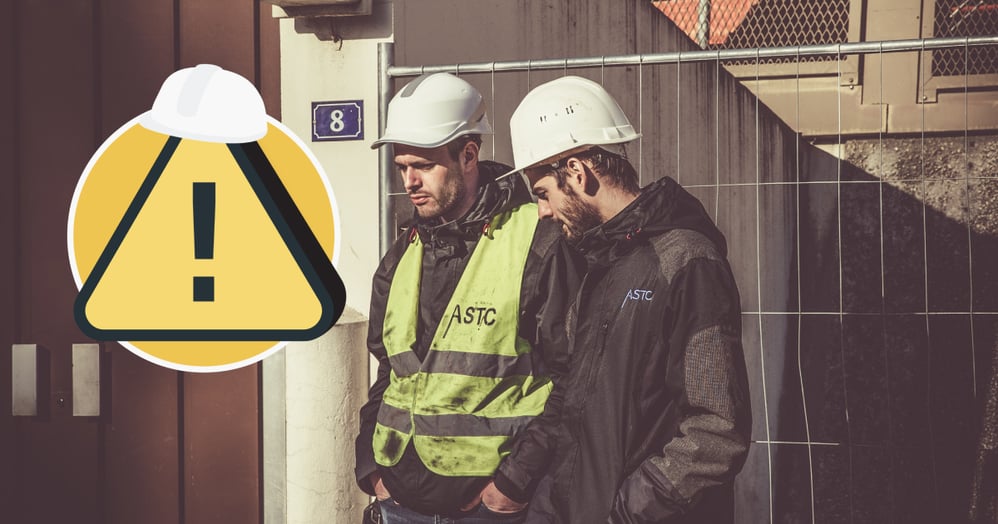Health and Safety in Plumbing & Gas - Regulations and Policies
by Team Tradify, March 30, 2023

Table of Contents
Working in the plumbing and gas industry comes with its fair share of challenges. And while your focus might be on providing your customers with gas safety certificates or other important safety checks, you still need to consider your own well-being. Here are some of the most common health and safety risks in the plumbing and gas industry, how to avoid them, and local policies and regulations that you need to know.
Wondering what your staff think about health and safety? Find out with our free Health & Safety Survey!
Short on time? Skip ahead!
- 1. Hazards and risks
- 2. Health and safety policies and regulations
- 3. Tradify job management software
1. Hazards and risks
Stress
It’s the most common hazard but also the least noticeable—which is why mental health issues are so dangerous. Running a plumbing & gas business can put you under immense pressure. Between meeting customers’ standards, managing staff, and all the office work that comes with the job, stress can add up, causing burnout and mental health strain.
Here’s how you can avoid stress and burnout:
- Take breaks when you feel the stress building up. It might seem like you don’t have the time, but coming back to work refreshed will mean greater productivity and better work. Check out our article on how to keep your business running while on a break.
- Get decent job management software to reduce the admin burden. Tradify is a great option that can do wonders for your business management. Some of our customers save 10+ hours/week on admin!
Harmful materials
As a plumber, you can find yourself in all sorts of situations where harmful substances and materials may be lurking. Asbestos and lead pipes are two examples of harmful materials that can cause numerous health and safety risks. To avoid the dangers of coming in contact with these materials, try the following.
- Use appropriate PPE.
- Ask your customer or client if they’re aware of any harmful materials on site.
- Evacuate the area immediately if you notice a harmful substance or material on the worksite.
Hot water, steam, and chemicals
If the right precautions aren’t taken, certain substances can cause skin/eye irritation and burns to the skin or even the respiratory system.
- Always wear PPE and appropriate clothing.
- Use a thermal camera if you’re unsure whether a surface or area is hot.
- Keep areas with potentially hazardous chemicals or temperatures restricted to authorised staff.
Slips, trips, and falls
It’s important to be aware of your surroundings, especially if you’re working in areas where slips, trips, and falls can occur. Try these tips to stay safe.
- Wear footwear with good grip.
- Use warning signs or barriers when floors are wet.
- Be mindful that the soles of your shoes may be wet, even when you’re on a dry surface. Take caution on staircases, stepladders, and polished floors.
- Keep confined areas restricted to a few people.
Fire
Fire is one of the most common and severe health and safety risks in the plumbing and gas industry. It’s extremely important to have measures in place to prevent blazes or explosions.
- Carry out regular fault checks on equipment such as power tools.
- Use gas detectors.
- Carry a portable fire extinguisher.
2. Health and safety policies & regulations by region
🇺🇸 United States
While the Occupational Safety and Health Administration (OSHA) sets standards and regulations related to plumbing and gas work, be sure to check if there are any unique state or local laws in your area. The Environmental Protection Agency (EPA) also has guidelines related to how hazardous materials should be safely used and disposed of.
🇬🇧 United Kingdom
Those in the UK need to follow the Gas Safety (Installation and Use) Regulations 1998, which sets guidelines for the safe installation and maintenance of gas appliances. The Health and Safety Executive (HSE) enforces these regulations and ensures that gas installations are safe.
🇦🇺 Australia
In Australia, the National Construction Code (NCC) provides safety requirements for plumbing and gas installations. The code is enforced by various state authorities, depending on where you’re located.
🇳🇿 New Zealand
The Plumbers, Gasfitters and Drainlayers Act 2006 sets out all the safety requirements that plumbing and gas professionals need to follow. Worksafe is another great resource you can use to double-check what’s required to meet health and safety standards onsite.
3. Get your life back with Tradify job management software
As your business grows, so does the amount of admin that needs to happen behind the scenes. Keeping track of jobs, scheduling, client information and invoicing are time-consuming and can quickly take you away from the task at hand.
Specialised plumbing and gas job management software like Tradify provides an all-in-one solution for your day-to-day processes in one streamlined hub. You’ll have everything from quoting to scheduling, job management to invoicing — all at your fingertips.
For an all-in-one fix that’ll put your day-to-day quoting, scheduling, job management and invoicing processes into one, streamlined system, Tradify is a must-have tool. Try it free for 14 days.
Plumbing & Gas Health and Safety - FAQ
There are a lot of hazards and health and safety risks involved in working in the plumbing & gas industry. Knowing these hazards and risks (and how to avoid them) can make all the difference in keeping you, your staff/coworkers, and your customers out of harm's way, while staying compliant with local laws and regulations.
There are many risks and hazards associated with plumbing & gas work. These include (but are not limited to) stress and burnout; slips, trips, and falls; fire, and exposure to harmful chemicals and substances.
You should always be on the lookout for potential hazards on the worksite. Take a look at local regulations and policies, which will give you a good indication of what you should be looking out for.
Additionally, you can hold regular health and safety meetings with your team or create a survey to gain extra insights.
To prevent slips, trips, and falls on the worksite, ensure that all wet surfaces are dried as soon as possible, make footwear with decent grip mandatory, and use plenty of signage to indicate when a surface is slippery.
Plumbing & gas is a demanding, labour-intensive profession that often requires a lot of physical exertion. Because of this, musculoskeletal injuries can be quite common in the industry.
Because of this, it's important to know how such injuries typically occur and how to prevent them.
Related articles

How To Set Up a Google Business Profile (for Trade Businesses)

Aussie Electrician Reduces Admin Time by 95%

Squeaky Clean Scheduling for Pro Carpet Cleaning
Give Tradify a go for free!
Save 10+ hours/week on business admin with the highest-rated job management software for tradespeople.
With free one-on-one training and phone support, it's never been easier to get started.



